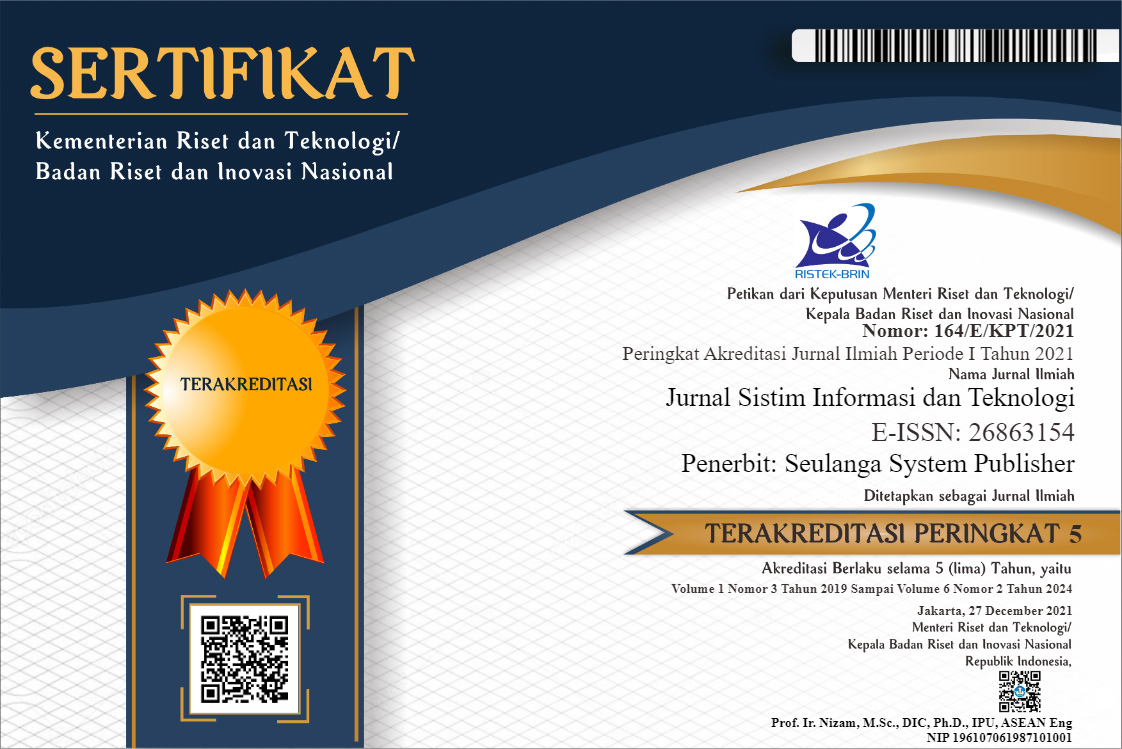Klasterisasi Penggunaan Trafik Internet Menggunakan K-Mean Clustering
DOI:
https://doi.org/10.37034/jsisfotek.v4i3.141Keywords:
K-Mean, Clustering, Dnsmasq, Data Mining, Internet TrafficAbstract
The use of internet traffic in a government office needs to be monitored carefully to obtain efficient and effective use. The internet line that has been provided is an official facility funded by the people's budget, so it needs to be monitored carefully. Domain Name System (DNS) provides rich and interesting data, and can be extracted to reveal information that can be analyzed for various purposes such as security measures, measuring traffic usage levels, bandwidth restrictions, user profiling to other policies implemented in a network. This study aims to make a clustering of the use of internet traffic so as to provide benefits that can be used to Improve Network Services (QoS), make efficiency of bandwidth usage and create user profiles. This research was conducted based on DNS Log which is operated on a network connected to the internet. In this study, it is shown how to consolidate traffic on port 53/udp to collect DNS logs, so that in this way the activities of internet users can be recorded in a centralized server until finally used as a primary data source. The datasets used are information extraction from the DNS Server log file (dnsmasq) which was retrieved for 5 working days in the period of working hours. The total extracted datasets used are 213 records. The available data is then processed to get the target cluster by utilizing the concept of data mining using the K-Mean Clustering method. The results classify the use of internet traffic into 3 clusters, namely high, medium and low. Each cluster consists of Kla1 is 23, Kla2 is 3, and Kla3 is 160. This research can be used as a reference in grouping internet traffic so that communication lines are well and smoothly maintained.
References
Hadi, H. A., Dwilestari, G., Faqih, A., & Nuris, N. D. (2022). Manajemen Authentifikasi User Menggunakan Metode Radius Server pada RS Jantung Hasna Medika. KOPERTIP: Jurnal Ilmiah Manajemen Informatika dan Komputer, 6(2), 34-41. DOI: https://doi.org/10.32485/kopertip.v6i2.133
Rubangiya, R., Hartati, T., & Wijaya, Y. A. (2022). Analisis Data Lalu Lintas Jaringan Di Kantor Cangehgar Cyber Operation Center Menggunakan Algoritma K-Means. Network Engineering Research Operation, 7(1), 75-84. DOI: http://dx.doi.org/10.21107/nero.v7i1.327
Salam, N. N. (2013). Analisis Implementasi Kebijakan Publik: Studi Kasus Pemblokiran Konter Pornografi di Internet (Doctoral dissertation, Fisipol UGM Politik dan Pemerintahan dh. Ilmu Pemerintahan).
Amiel, T., & Sargent, S. L. (2004). Individual differences in Internet usage motives. Computers in Human Behavior, 20(6), 711–726. https://doi.org/10.1016/j.chb.2004.09.002
Dakhgan, A., Hadi, A., Al Saraireh, J., & Alrababah, D. (2017, October). Passive DNS Analysis Using Bro-IDS. In 2017 International Conference on New Trends in Computing Sciences (ICTCS) (pp. 121-126). IEEE. https://doi.org/10.1109/ICTCS.2017.47
Maimon, O., & Rokach, L. (2010). Data Mining and Knowledge Discovery Handbook (2nd ed. 2010 ed.). Springer.
Larose, D. T. (2014). Discovering Knowledge in Data: An Introduction to Data Mining. Wiley.
Ginantra, N. L. W. S. R., Arifah, F. N., Wijaya, A. H., Septarini, R. S., Ahmad, N., Ardiana, D. P. Y., ... & Negara, E. S. (2021). Data mining dan penerapan algoritma. Yayasan Kita Menulis.
Turban, E., Aronson, J. E., Liang, T., & McCarthy, R., V. (2004). Decision Support Systems and Intelligent Systems (7th ed.). Prentice Hall.
Mohd Ariffin, M. A. (2020). Network Traffic Profiling Using Data Mining Technique in Campus Environment. International Journal of Advanced Trends in Computer Science and Engineering, 9(1.3), 422–428. https://doi.org/10.30534/ijatcse/2020/6691.32020
Wang, Q., Li, L., Jiang, B., Lu, Z., Liu, J., & Jian, S. (2020). Malicious Domain Detection Based on K-means and SMOTE. Lecture Notes in Computer Science, 468–481. https://doi.org/10.1007/978-3-030-50417-5_35
Cui, H., Yang, J., Liu, Y., Zheng, Z., & Wu, K. (2014). Data Mining-based DNS Log Analysis. Annals of Data Science, 1(3–4), 311–323. https://doi.org/10.1007/s40745-014-0023-7
Grzinic, T., Perhoc, D., Maric, M., Vlasic, F., & Kulcsar, T. (2014). CROFlux — Passive DNS method for detecting fast-flux domains. 2014 37th International Convention on Information and Communication Technology, Electronics and Microelectronics (MIPRO). https://doi.org/10.1109/mipro.2014.6859782
Downloads
Published
How to Cite
Issue
Section
License
Copyright (c) 2022 Jurnal Sistim Informasi dan Teknologi

This work is licensed under a Creative Commons Attribution 4.0 International License.









